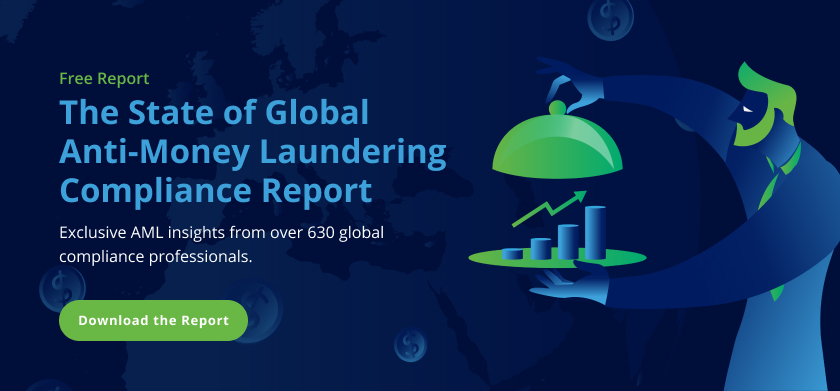
Every year, I borrow a lab coat from our Research Team, jump in my Delorean, and travel to the future to bring you a list of predictions about fraud and financial crime trends for the coming year. With 2022 coming to a close, let’s revisit the fraud forecasts we made and see how I fared in fincrime fortunetelling.
Prediction 1: ATO Fraud and APP Fraud Grows via Social Engineering
Outcome: Right 
When we first started seeing account takeover fraud (ATO), we saw fraudsters impersonate people via phishing attacks to gain access to their accounts.
Today, fraudsters often don’t bother with the bank’s controls; they use scams to attack individuals directly instead. They glean information from online sources and then contact their targets. The victim thinks, “of course, this is my bank – they know all about me.” It’s that personal touch that makes scams highly effective. So effective that scam losses are three times greater per loss than those of old-fashioned ATO impersonations like phishing, vishing, and smishing. The extra effort a fraudster has to put into a scam vs. an ATO attack provides such a strong ROI that this trend isn’t going away anytime soon.
Prediction 2: Real-Time B2B Payments Create Fraud Vulnerabilities
Outcome: Near Miss 
We got this one wrong-ish. Right now, new payment methods are real-time, but established payment methods are not. We’re witnessing the transition to real-time payments, but, I simply predicted that everything would move quicker than it has. Legacy payments are reliant on technology, which is delaying the full transition. That’s because technical evolutions tend to be more lumpy than linear.
The appetite for change is definitely present, and we’re seeing it in pockets. Still, we haven’t seen the inflection point for real-time to take-off at the macro level. In the current economic climate, we’ll likely see a decrease in investments come into play in 2023. That will slow progress, but not halt it. In about three or four years, we’ll see real-time by design.
Prediction 3: IoT Opens New Fraud Avenues
Outcome: Wrong 
I just got this wrong. The prediction was that people would use digital assistants such as Siri, Google Home, and Alexa to make payments. The thought was that Apple was starting to embed user-friendly technology to allow customers to iMessage payments. But we’re not seeing social adoption of non-bank payment techniques.
Perhaps people aren’t comfortable with this method yet. We know that banking historically is inert; people go back to the thing they trust will work. They choose certainty above ease even if there’s more friction with the certain method.
The other factor impacting adoption is that these payment methods haven’t been pushed, sponsored, or advertised by any of the companies creating digital assistants. There’s no clear value proposition for the companies or their customers.
Prediction 4: Fraud Challenges for Challenger Banks
Outcome: Right-ish 
This happened, but not the way I thought it would.
I genuinely thought fraudsters would look at challenger banks and think, “They’ve got a new control framework. There will be weaknesses. Let’s go after them!” But that’s not quite what happened.
We saw challenger banks and fintechs being used as mules. They’ve been targeted in the fraud ecosystem because they have weaker KYC and AML processes; it’s easier for a fraudster to open an account with them. Fraudsters are siphoning money from larger financial institutions to challenger banks and fintechs. So they’ve become recipients of fraud rather than defrauding their customers.
Ultimately, fraudsters did target challenger banks and fintechs, but not quite in the stage of the fraud ecosystem that I thought they would.
Prediction 5: Millennials and Gen Z Face Fraud
Outcome: Right 
We were 100% right on this one. Fraudsters targeting millennials and Gen Z has only grown through the year.
Fraudsters traditionally targeted older people or people who weren’t digitally savvy. But this year, as we predicted, they went after people who are digitally savvy from a social media perspective but are not financially savvy.
Millennials have always known digital media. They didn’t move to it like every generation before them; they grew up with it. Yet, that knowledge hasn’t protected them in the financial arena. In fact, the familiarity and casualness of an online environment have made them more susceptible to fraudsters asking them to make transfers or scamming them in other ways.
The problem is so widespread that banks are reacting to it with the concept of polluter pays. Basically, the question is should the social media giants help protect their users from the financial exposure created on their platforms? It’s a debate that some might say is settled in the UK. But in reality, this question is far from answered, particularly on a global level.
Prediction 6: Get-Rich Quick Schemes Get Bigger
Outcome: Right 
This didn’t really happen the way I thought it would, but to be fair, the value of cryptocurrency just kind of collapsed. It’s hard to have a get-rich-quick scheme when there’s no value in crypto for consumers.
However, crypto is definitely valuable to fraudsters. They use crypto as a layering mechanism. It’s an opaque source of storage and a great way to hide their criminal gains.
Prediction 7: Romance Scams Reign Supreme
Outcome: Right 
Fraudsters love romance scams. Pun intended.
COVID popularized romance scams. It created the perfect environment because people were isolated, vulnerable, and using new communication methods for connections. Yet, as we’ve gone back to pre-COVID behaviors, romance scams continue. That’s because scams in general, and romance scams in particular, manipulate emotions. When you feel emotionally attached to someone, you might not listen to that inner warning voice until it’s too late.
Romance scams aren’t as popular as they were at the height of the pandemic, but they’re certainly rated in the top three scam types of the year.
I got five out of seven predictions right – and no skateboard or plutonium-powered Delorean required. I’m good with that! Tune in tomorrow, when we truly take you back to the future and reveal our fraud trends and predictions for 2023.
Share this article:
Related Posts
0 Comments6 Minutes
A Guide to Secure, Seamless User Authentication in Payments
Online payments demand a delicate balance between security and user experience. Consumers…
0 Comments7 Minutes
Combating Emerging Scams in the Philippines
The Philippines is witnessing remarkable growth in digital banking. Unfortunately, a…
0 Comments5 Minutes
Feedzai is a Leader in the 2024 IDC MarketScape for Enterprise Fraud Solutions
Exciting news! Feedzai, the world’s first RiskOps platform, is proud to have been named a…


